You Gotta Keep ’em Separated
The Case for Bento Box Discovery Interfaces
The Case
So, I submit to you the following.

First the obligatory, here's where the bento box UI metaphor comes from. A Japanese lunch where

several different types of delicious food

are subdivided into little compartments.

Bento ...
Bento box.

And so here we have a search results UI where
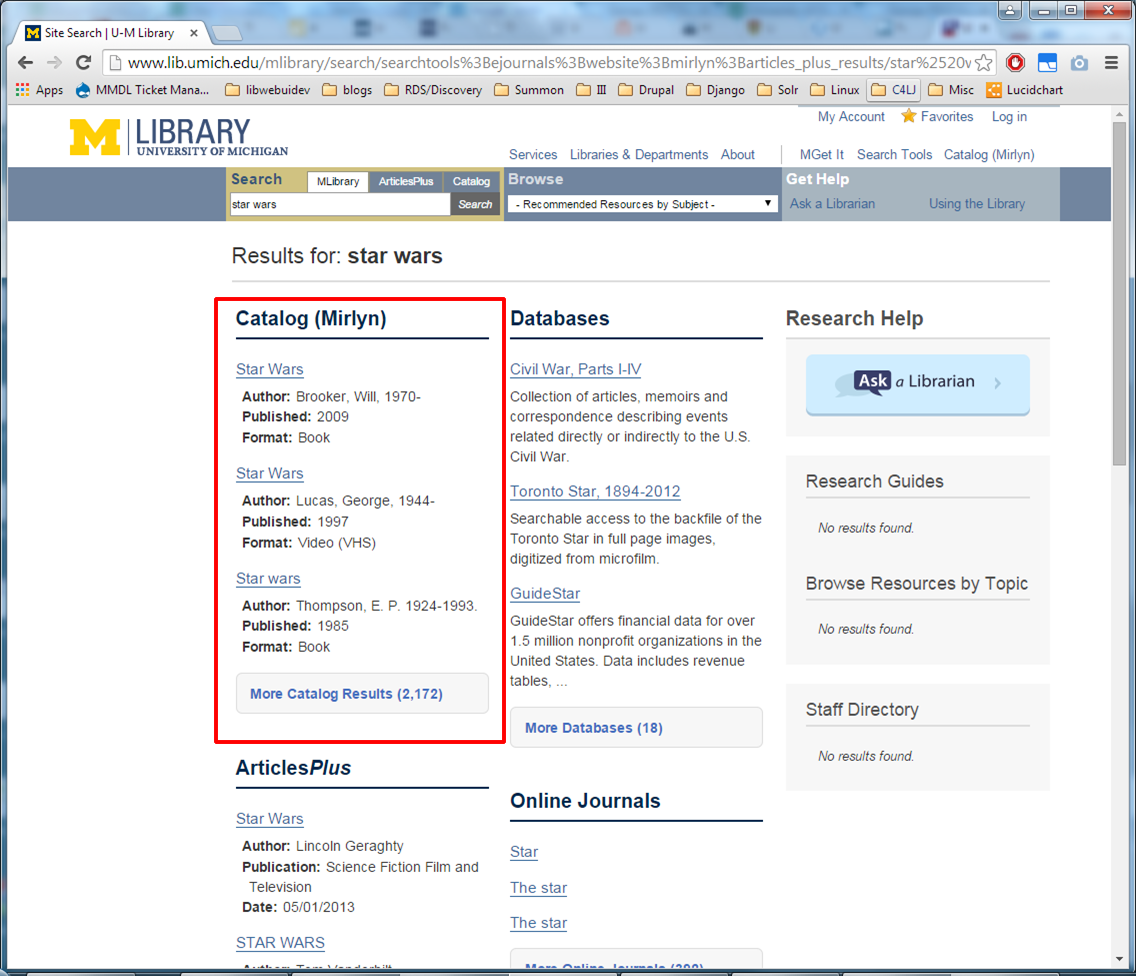
results are subdivided

into compartments by category,

Bento ...
like a Japanese bento box. This is from University of Michigan Libraries. Which is great and all, but isn't this just another in a long line of library hacks and workarounds?

Well, last I'll show you another search results UI where, again,
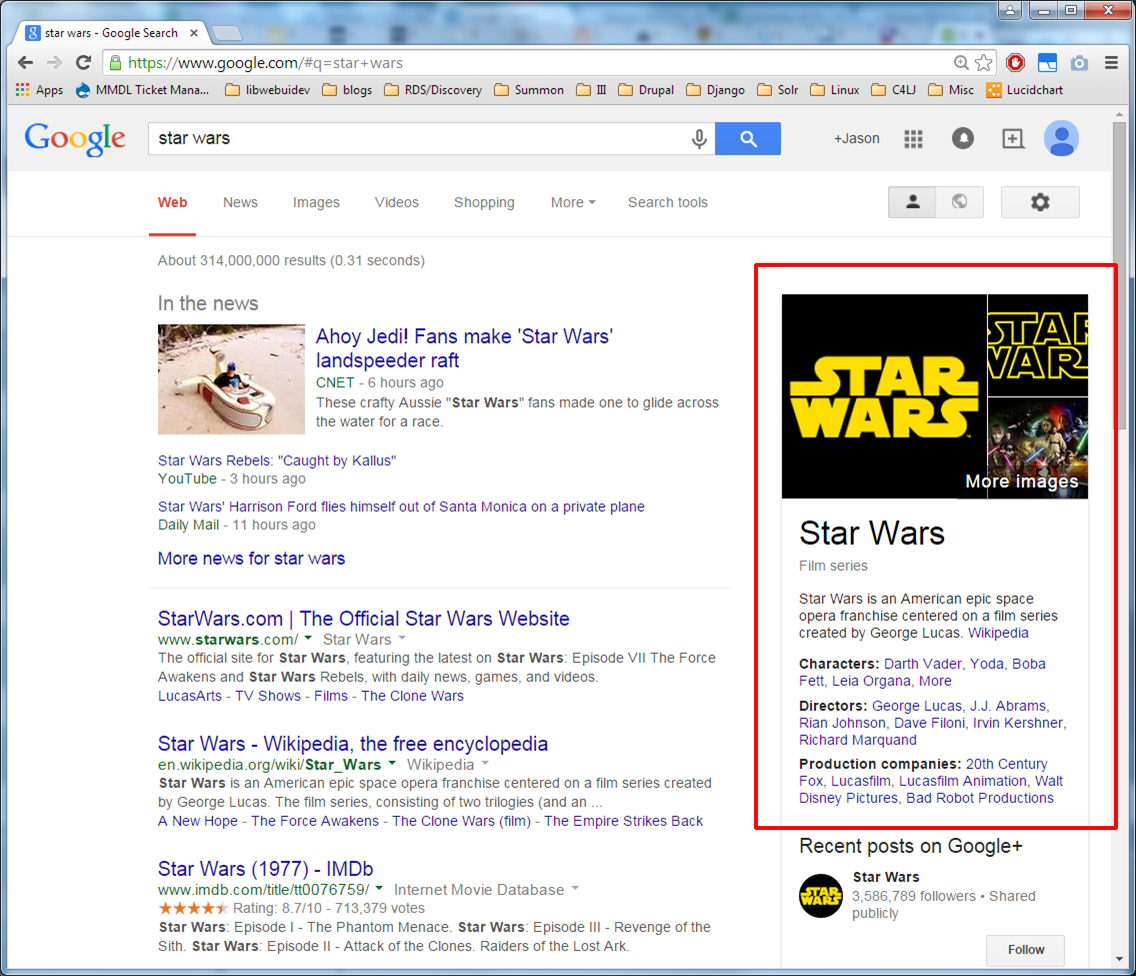
results are subdivided

into compartments by category.

Bento ...
Bento box ...




from Google!
Questions?
Questions? [Hopefully pause for laughter] But seriously—I do have to fill 20 minutes, here...
You Gotta Keep ’em Separated
The Case for Bento Box Discovery Interfaces

So, the thing about talking about this at Code4lib is that the Code4lib community is professionally pretty diverse. And when we're talking about bento box interfaces,
#justacademic
librarythings
we have a distinct bias toward academic libraries.

I mean that *is* where the term originated and, as far as I know, that's mainly the context where it's used.
And—especially in academic libraries, we have sort of a collective history of implementing what we might call

“hacks,” especially when trying to facilitate a particular user experience on our websites. That's not to put anyone down, by the way, as we're all pretty much in this boat. We often have to get

different systems from different vendors to play nicely together.

Sometimes we need to customize things that aren't easily customizable.

Sometimes we need to try to get data out of systems that just don't want to give it up.

Sometimes we just need to make things work together that weren't meant to work together.

Granted, things are better than they used to be. Open source software in libraries is thriving, and it's become more or less the norm for vendors to offer APIs or other methods of getting at our data.

And so we build better and more sophisticated hacks—like this lovely treadmill bike. Or bento box discovery interfaces.
But, you know, as I look at resource discovery solutions in libraries and outside of libraries,
Not
#justacademic
librarythings
I'm seeing bento box as an interesting type of UI for more reasons than just the solutions it provides for the immediate problems it was designed to work around. While I think it's true that those problems are real for academic libraries and bento box UIs are still attractive to us as a solution to those problems, I'm becoming more convinced that there's more to it than that.
Bento Box UI as Hack
But this is mainly what I'm going to be talking about, because I promised I have some stats to share that might be relevant. So let's delve into “bento box UI as hack.” What
Problems
are the actual problems that it was meant to solve?
Problems
The story of Library
Discovery (so far)
Discovery (so far)
To answer that, we have to get into the story of library discovery.
Problems
#justacademiclibrarythings
And I really tried to think of a way to start this next part that didn't involve telling this story, because it's one we know so damn well. But, just in case, I'll refresh our memories and make sure we're all up to speed.

Library users have repeatedly told us:

Google—

:-)
good, easy to use!
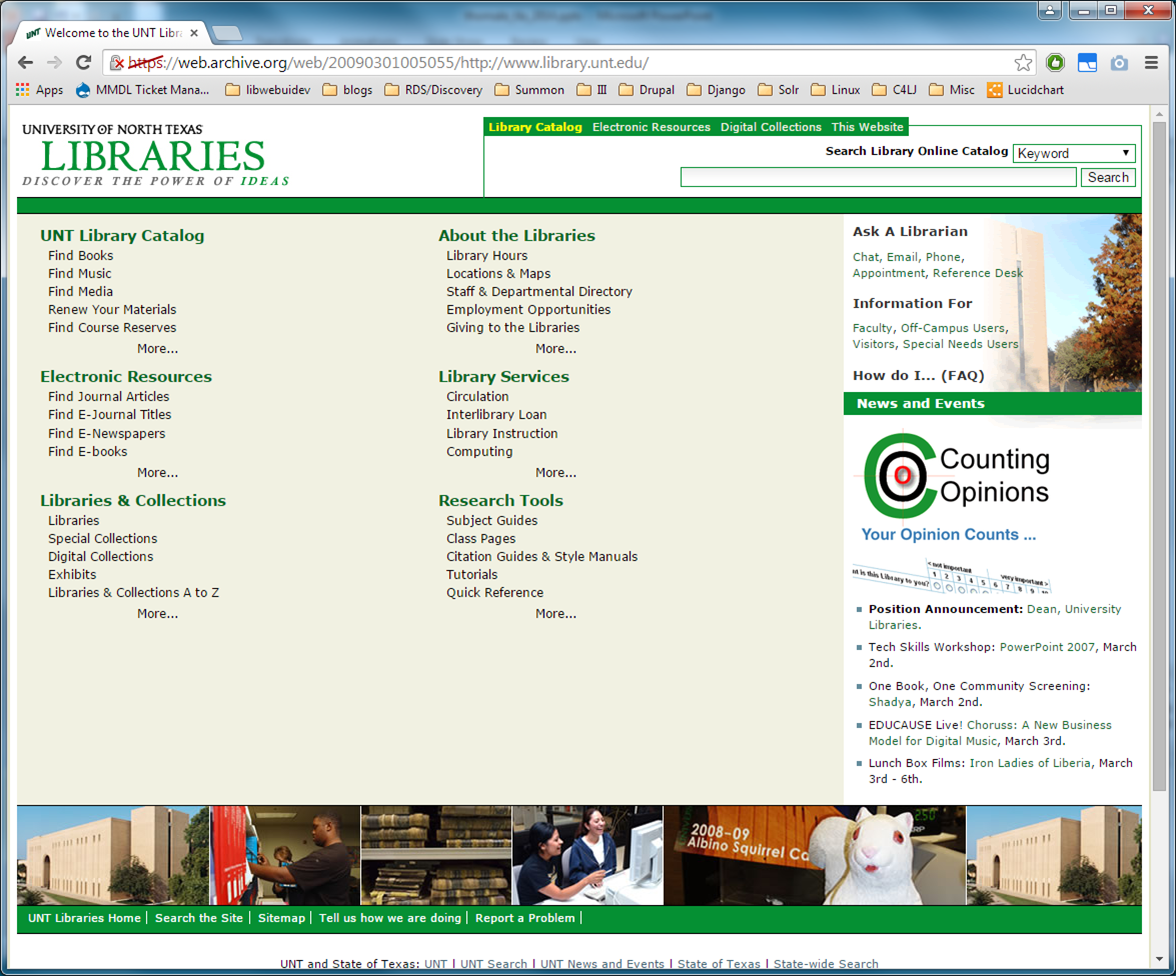
library sites—

:-(
bad, hard to use.

So we've said: let's make

library sites
==
more like

Yeah!
?
And what *is* Google?

A single search box that
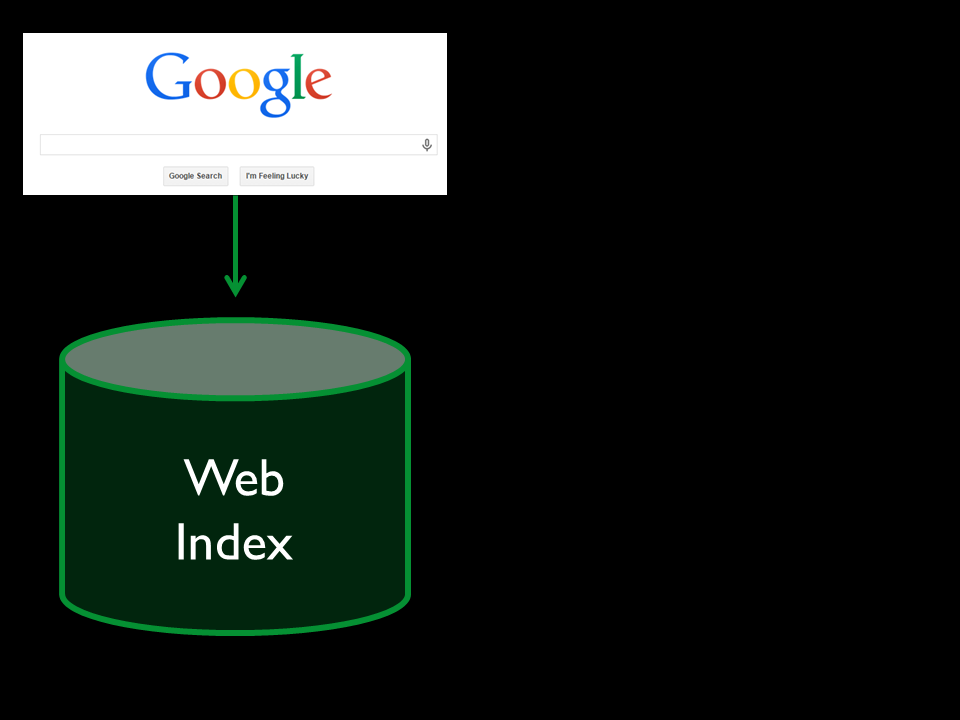
searches a Web index

and presents a list of relevance-ranked results. Right?
?
And what are library systems?

Information silos! Many data stores, impossible to search at once,

users have to know which ones to use or how to find out which ones to use,

interfaces are all different, searching takes forever.

So we said: well okay,

let's try taking a user's

search and sending it out

to a bunch of databases for them at once.

Let's even bring the results together on the fly into one list!
Yeah!
Yeah! So much like Google!

:-(
Nope. Not like Google. Too slow. Way too many possible endpoints and we can't search them all at once. No way to rank results effectively.

So we said: all right,

what we need is a central index. That's what Google has.

Some of us started putting stuff into Solr.

But only the stuff we could get.

And we put search interfaces on top.
Yeah!
Yeah! Next Generation Catalogs! So awesome!

Users were like

Articles?
What about articles?

So we said:

Fine.
Fine. Let's make

deals with publishers and content providers,

and build a big ass central index of licensed content.

And—hey, now we can even put the catalog and all of our other stuff in it too!
Yeah!
Yeah! Web scale discovery!
*Now* are we like Google?

Let's see. Single index for our stuff?

Check. Single relevance-ranked results list?

Check. Single search box?

Check.
Okay. So...yeah. A lot like Google.

Right?

:-)

:-)
:-\
Meh
Meh. The similarities are skin deep.
?
Look, what is it *really* that makes Google Google?

Is it the Google interface?

the single search index?

the Google style of search results?
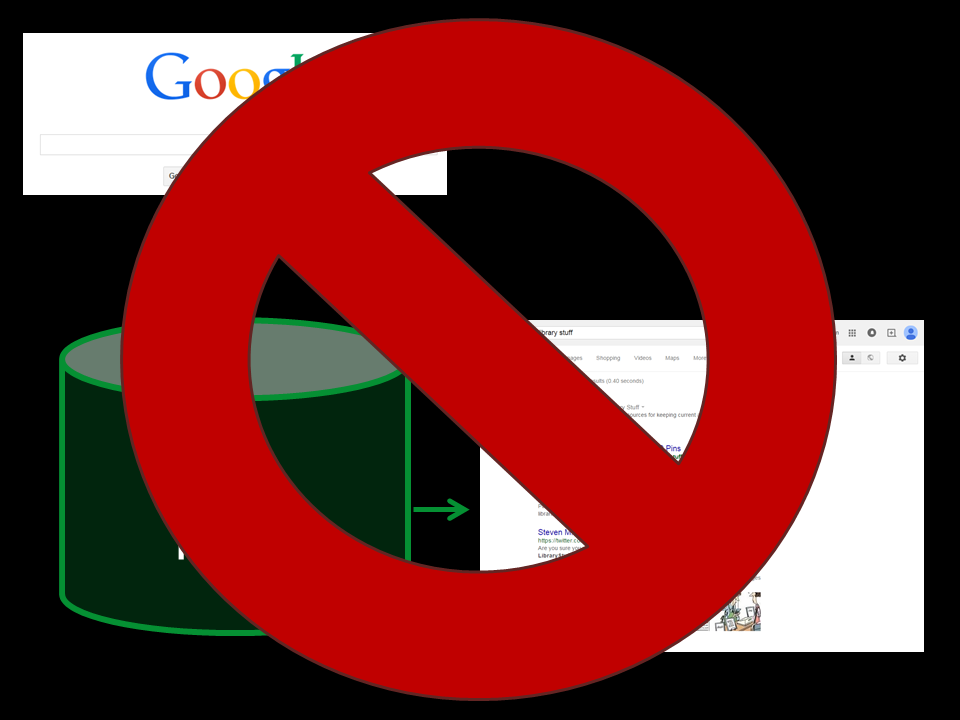
No—

it's the Web itself. More than that, it's how
Beyond full-text indexing
Google moved beyond full-text indexing
Harnessed ...
and actually harnessed the unique properties of the Web—
Hyperlinks
the hyperlinks,
Loosely structured
the loosely structured,
Open
openly-available data stored in
Standard
standard
Machine-readable
machine-readable document formats—and figured out how to do
Crazy good relevance ranking
crazy good relevance ranking for Web searches. *That's* what made them the best, and that's why people use them.

And library data doesn't have the same characteristics as Web data. It just doesn't. Though I know lots of folks working on Web Scale Discovery have made big strides, nobody has *solved* relevance ranking for full library discovery the way Google solved it for the Web.

So yeah users tell us they want us

Be like Google!
to be like Google
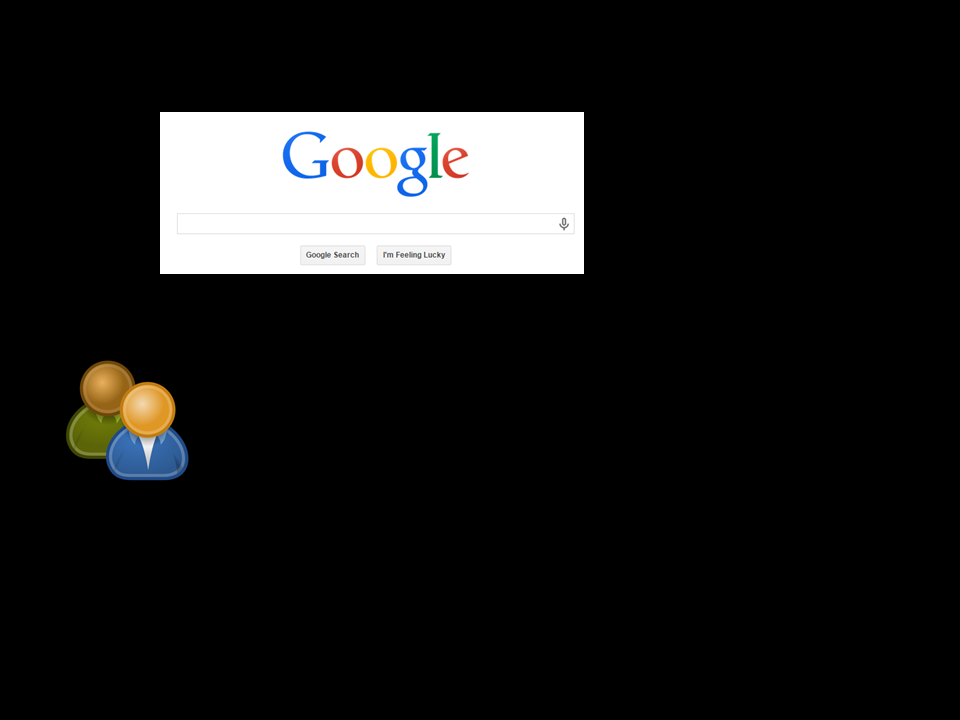
because Google

gets them to the information they want with little fuss.

And, on our library websites, when we're trying to figure out how we want to direct different user groups with various and possibly incompatible tasks to find the resources they need to solve their tasks, that's what we're trying to do, too.
What we don't want

is to funnel everyone to one system that looks, feels, and acts like Google but then

fails to return the most relevant results for major categories of user tasks.
Bento Box UI as Hack
So Bento box UI design is a workaround for this problem. It's mainly an attempt by libraries to deliver a single search that works better across a wider variety of user scenarios, given the realities of library systems and data. There are at least three things that it tries to do.
More equal weight to resources from different systems
It gives more equal weight to resources from multiple systems that might otherwise drown each other out in a single results list. This helps bring more variety to a user's immediate attention.
Funnel users to systems after search
It funnels people to the resources they need in the particular systems that natively store and provide services over those resources *after* they've searched.
Separate and group by resource type
And it attempts to accommodate different uses by separating results visually by resource type. People don't have to futz around with filters and facets that they tend not to use anyway.
Strategery
From a strategic POV, bento box design also has benefits: mainly that libraries maintain more control over their primary search interface,

relegating vendor interfaces to components that can be more readily switched out. (If you have the technical staff and expertise.)
Evidence
So. I'm standing up here talking like all of this is obvious, and you might assume that I have clear evidence to back me up that, number 1, the problems that these UIs

were designed to solve actually exist and, number 2,

that these UIs actually solve them.

The truth is that the evidence isn't clear, especially when just looking at the user studies that are available.

:-)
On the one hand you have many studies showing pretty high user satisfaction with combined-results systems, primarily from undergraduates.

Articles
Books
And on the other hand are studies suggesting that most users come to the library interface knowing at a very broad level what type of resource they need to get (like articles or books), and so results that blend them together are confusing.

I don't actually have any answers. Sorry. BUT, I might have something useful to add to the picture.
Stats!
Yes, that means it's almost time for stats show-and-tell.
BACKGROUND
First I want to mention a few things that are useful in interpreting the stats.
4 years
During my time at UNT, part of my job has been to
Resource discovery experience
help guide improvements to our users' resource discovery experience, including:
Library catalog redesign: September 2011
a redesign of our library catalog,
Summon (beta): Spring 2012
Implementation of Summon, which ran as a beta in Spring 2012 and was released as a live service in the Fall
Website redesign: September 2012
along with a website redesign. In the redesign, we featured

a tabbed search box—the “Find Box”—front and center. Articles, which searched Summon, was the default tab,

and a Books and Media tab that searched the catalog was also prominent.
Google Analytics
We ran Google Analytics on both systems to collect stats.
September 2014
So by September 2014
2-3 years of data
we'd accumulated 3 years of data on our catalog and over 2 years of data on Summon. At that point we were already in the planning stages on a bento box design,
→ Bento box design
and I wanted to see what I could glean about how people used our existing discovery systems. So that's when I did my analysis.
Primary question:
My primary question was:
Do users use articles and books differently?
do our users actually seem to use articles differently than they use books and other catalog materials? Are those useful distinctions to make in our interfaces? And to answer that it seemed I also needed to prove two other things: one, that, in our environment,
Summon
==
Articles?
people *are* mainly using Summon as an articles search and
Catalog
==
Books & Media?
they *are* mainly using the catalog to find books, media, etc. And two,
Different use patterns
that the use patterns we see between those two systems is different enough to suggest different use cases for those types of materials.
METHODS
To conduct the analysis, I wrote Python scripts that
Get data via Google Analytics API
pull data from each of the two Google Analytics accounts—Summon and the catalog—using the GA API, for the period of
August 2011 to August 2014
August 2011 to August 2014. I focused mainly on two different types of stats:
Pageviews &
Search queries
pageviews and search queries.
Pageviews ~= Searches
I used pageviews as an approximation of searches. I filtered by URL to remove anything that was not a hit on the first page of a search results screen, to ensure that I was comparing apples to apples in each system.
Then I used additional GA filters to look at different aspects of usage in each system, including
Aggregate patterns
Aggregate patterns.
Distance usage
Distance usage.
Find Box usage
Usage coming from the Find Box on the homepage compared to direct usage.
Search options
And usage of search options, including use of the options on the Find Box as well as usage of search options within each system.
Search queries
With search queries I attempted to do some very rough query analysis.
I mainly looked at
Top 100
the top 100 queries in each system—
Top 100 overall
top 100 queries overall and
Top 100 via Find Box
top 100 entered via each Find Box tab. I also attempted
Normalized queries
to normalize queries (where I did case and punctuation normalization and removed stop words), and then I also looked at the top 100
Words
individual words,
Bigrams
top 100 bigrams,
Trigrams
and top 100 trigrams in each data set. I also looked at
Frequency distribution curves, query length
a couple of overall characteristics of the data set that I won't have time to go into.
FINDINGS
No surprise here, but, I do think my findings answer my primary question in the affirmative with at least enough certainty to help make an argument for bento box UI design.
Aggregate Use
Let's look at some aggregate stats for each system.

Here the line at the top shows catalog searches and the one on the bottom shows Summon searches, from August 2011 to August 2014. Sorry, I know this might not be easy to see.

Here is the time period in Spring of 2012 where we implemented Summon as a beta service, where Summon use is low,

and starting here is where Summon went live. So during this entire period, Summon and the catalog were both live, searchable via their respective tabs in our Find box.
The first thing I want to note here, is that—

we see a dip in catalog usage here as we were ramping up Summon,

but since Summon has been live, usage has equalized, and people have been using both systems in about equal amounts. In hindsight this might not be surprising, but, before we implemented Summon, we were a little curious whether or not Summon would cannibalize catalog use. But even after a couple of years, we see *both* a lot of search activity in Summon *and* people are still searching the catalog. I know this finding might seem kind of trivial, but it suggests that both systems *are* used and *are* necessary, if not that they outright fulfill different needs.
Next I want to point out two clearly different patterns of use in each system by semester.

In the catalog, we see each long semester (Fall and Spring) starting with high activity and then dropping off,

and in Summon, we see exactly the opposite pattern, where usage peaks near the end of the semester. (NCSU has noted that they've seen similar patterns.) Based solely on stats we can't say for sure what exactly these patterns mean, but they *are* obviously different.
One more thing I want to point out about this graph.

You see in each system these troughs that happen between semesters when everyone goes home. In Summon these troughs are deeper and wider than

they are in the catalog. When a semester ends, Summon use drops off immediately and remains low until the next semester begins, while catalog use generally remains a little bit steadier during semester breaks. So it appears that Summon use is a bit more tied to the academic calendar than catalog use. Again, it's different patterns of use.
Distance Use
Now let's look at distance usage.

This is actually showing local usage, using two different metrics for “local.” It compares all searches (the red line) with searches coming from Denton, TX (where UNT is located, the blue line) and searches coming from the unt.edu domain (on-campus, the green line). We clearly see here that the catalog gets substantially more use from local users than Summon.
Catalog
78.04% Denton
57.29% UNT
In the catalog, 78% of use comes from Denton, and 57% of use comes from on-campus,
Summon
50.40% Denton
25.38% UNT
while in Summon, 50% of use comes comes from Denton and only 25% of use comes from on-campus. Different patterns of use from different user groups.
Search Origin
Another angle: usage of these two systems by where users start their search sessions.

For the period of time after our website redesign, here's what we see. The red area in each graph shows the proportion of searches where the user's search session actually started from the Find Box on the homepage.
Summon
75.34% Find Box
In Summon that proportion is about 75%,
Catalog
40.47% Find Box
while in the catalog, it's only 40%. We see that nearly as many catalog search sessions start
Catalog
32.24% Catalog Home Page
on the catalog home page, at 32%.

So, maybe there's a picture materializing now that people do use these two systems differently. To help us start characterizing this use,
Summon
==
Articles?
I want to zero in on Summon.
I've mentioned that we primarily use Summon as a “find articles” search in our discovery environment. And that search actually limits to the “journal article” content type by default. But people can clear the default options by starting a new basic or advanced search, and of course they can change content type limits via facets, which of course people rarely do.
But we see some interesting things emerge if we dig down into the numbers.
Changed facets: 26.04%
Looking at Summon stats, we see that people change facets and filters only about 26% of the time (which falls in line with what other research has found, by the way).
Basic search: 8.26%
About 8% of searches are unfaceted basic searches, and
Advanced search: 6.47%
About 6% of searches are unfaceted advanced searches.
Find Box Defaults: 59.22%
That leaves about 59% of searches where the default filters set on the Find Box are not touched.
If we drill down into the 26% of searches where people *did* change facets, we see
Change Content Type: 9.23% of changes
changing Content Type accounts for only 9% of all changes.
And drilling down further into that category,
Remove Articles limit: 8.78% of content type use
only about 9% remove the “limit to Journal Articles” filter,
Exclude Articles limit: 0.54% of content type use
and only about half a percent use the “exclude journal articles” filter.
What actually accounts for the most Content Type activity is
Add Articles limit: 21.94% of content type use
*adding* the “limit to Journal Articles” filter, at almost 22%. And if we look at *only* the activity where people added a content type limit (as opposed to removing a limit or adding or removing an exclusion), we see that jump up to
Add Articles limit: 41.27% of content types added
41%.
?
So here are the conclusions I draw from these numbers.
Users don’t change the defaults
As we'd expect, people mostly don't mess with changing the defaults.
Users rarely change Content Type
Even when people do change facets/filters, they rarely change content type.
Users rarely remove the Include Articles filter
Even when people do use facets/filters, they rarely explicitly remove the Journal Article limit.
Users never exclude Articles
People almost never actually exclude Journal Articles.
Users deliberately add the Include Articles filter
When people do change content type, adding the Journal Article content type limit back into their search is what we see most often. In context of all searches this is still a relatively small number, however you have to keep in mind that, since that limit is present on most searches by default, the opportunity to add the limit is a lot rarer than the opportunity to remove it or add other content type limits. And yet it's still by far the most added content type.
Summon
==
Articles
This seems to validate our assumption that people *primarily* and even deliberately do use Summon for articles,
Summon
==
Articles (mostly)
though they don't *exclusively* use Summon for articles.
Catalog
==
Books & Media?
What about the catalog?
Queries
The best way to talk about this might be to look at our query analysis. The problem is that it's hard to show you the data in a presentation format, because it's mostly long lists of terms. But I'm going to try to show you enough to get the point across.
Catalog
In the catalog,
Overall, Catalog: Normalized
| video games | jstor |
| new york times | disney |
| ps3 | comedy |
| xbox | encyclopedia library information sciences |
| xbox 360 | geography |
| comedy films | horror films |
| game thrones | hunger games |
| wii | star wars |
| harry potter | adventure films |
| quarterly journal speech | horror |
looking at overall catalog searching, we see that the top queries tend to be searches related to video games, films, television, and books. We also see some searches in the catalog for particular resources—usually reference sources. This is just the top 20, but it's really similar to the rest of the top 100.
Find Box, Catalog: Normalized
| quarterly journal speech | asm handbook |
| new york times | ps3 |
| encyclopedia library information sciences | oxford english dictionary |
| game thrones | cambridge ancient history |
| geography | encyclopedia library information science |
| xbox | gre |
| critical terms literary study | dallas morning news |
| higonnet patricia | ecological footprint |
| global exchange free trade protectionism | chicago manual style |
| xbox 360 | ap stylebook |
If we look just at searches conducted via the Find Box, we see similar sorts of things, but heavier on actual books (again, mostly reference books) than media. We also see a couple of topical searches pop up.
Catalog bigrams and trigrams
Music, history, literature
If I showed you bigrams and trigrams, we'd see more topics emerge. Music, history, and literature (in addition to the pop culture terms we've seen) become more prominent.
Summon
Let's compare that to what we see in Summon. In Summon,
Overall, Summon: Normalized
| jstor | domestic violence |
| new york times | leadership |
| exceptional children | ebscohost |
| social media | child abuse |
| psychological science | bilingual education |
| autism | motivating employees |
| play therapy | library |
| psychology | quarterly journal speech |
| chromatography | email etiquette |
| party dudes | ebsco |
we mostly see queries related to academic topics or current events. We also see quite a few searches for databases or other types of aggregate resources,
Find Box, Summon: Normalized
| jstor | autism |
| new york times | play therapy |
| ebscohost | quarterly journal speech |
| ebsco | email etiquette |
| exceptional children | psycinfo |
| naxos | chromatography |
| psychological science | party dudes |
| social media | hoovers |
| psychology | proquest |
| ieee | child abuse |
especially when we look just at the queries conducted via the Find Box, which otherwise are very similar to the overall queries.
Summon bigrams and trigrams
Social sciences, political science, technology, education, library science
If we looked at bigrams and trigrams in Summon, then we'd see more of the same, and a lot of social science, political science, technology, education, and library science related topics.
So—I know this just gives you a small taste, but the takeaway I think is that,

by and large, we are seeing different kinds of searches for different kinds of things in each system,

and for the most part these do match up with our resource type categories.
Wrap Up
Okay, I'm about out of time, so let's wrap this up. When I proposed this presentation, I mentioned that the stats I wanted to show you

weren't exactly the “smoking gun” I was hoping for, and I think you see what I mean. In using this information to justify a bento box approach, I fully admit
Confirmation bias
that there may be a healthy dose of this going on here,
Lies
damn lies
statistics
And of course there's always this. But I mentioned at the beginning of my presentation
Not
#justacademic
librarythings
that I think bento box UI design is interesting for more reasons than just what's pertinent to our immediate academic library context, and in fact I think the problems BB UI is ultimately trying to address are universal.
In the usage stats I've shown you, I don't think it's a stretch to say we see evidence

Articles
Books
that people do search for and use different types of resources differently. And while we want to

offer people the ease and simplicity of a single-search box, we also want to make sure we're not railroading them into a particular use case

that makes them have to sift through tons of crap to find the things they want to find.
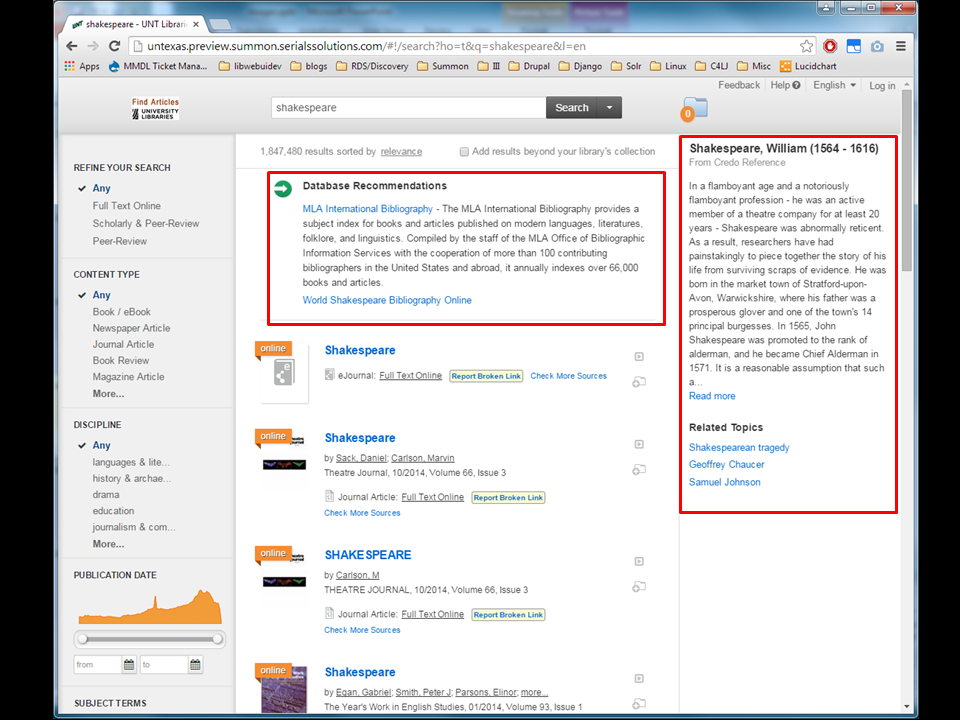
And *that,* I think,

is a completely universal concern
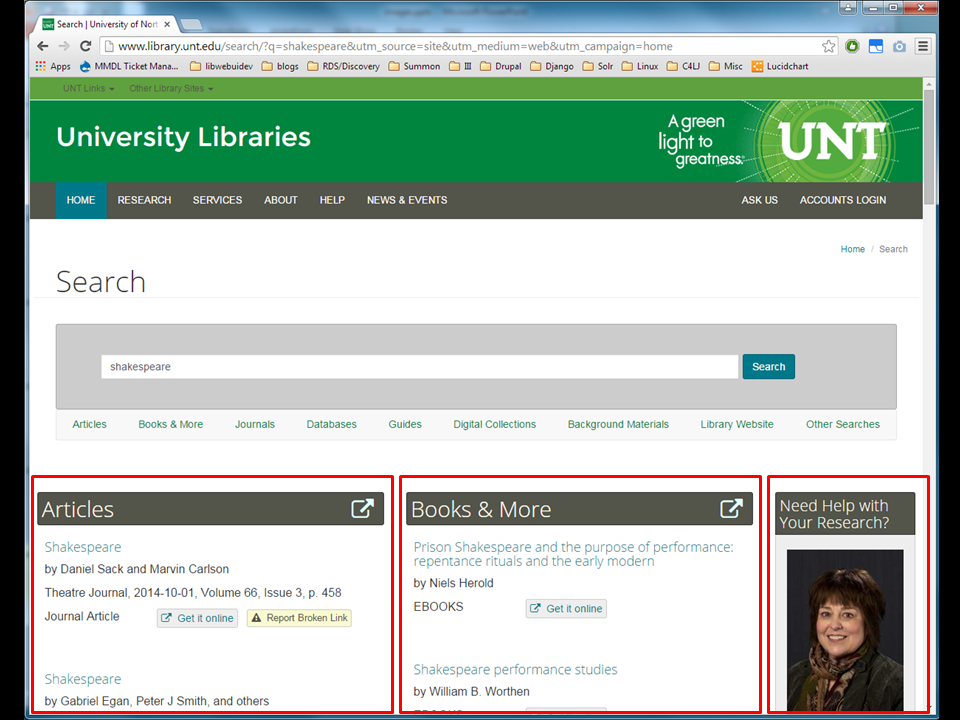
for *anyone*

designing *any* type
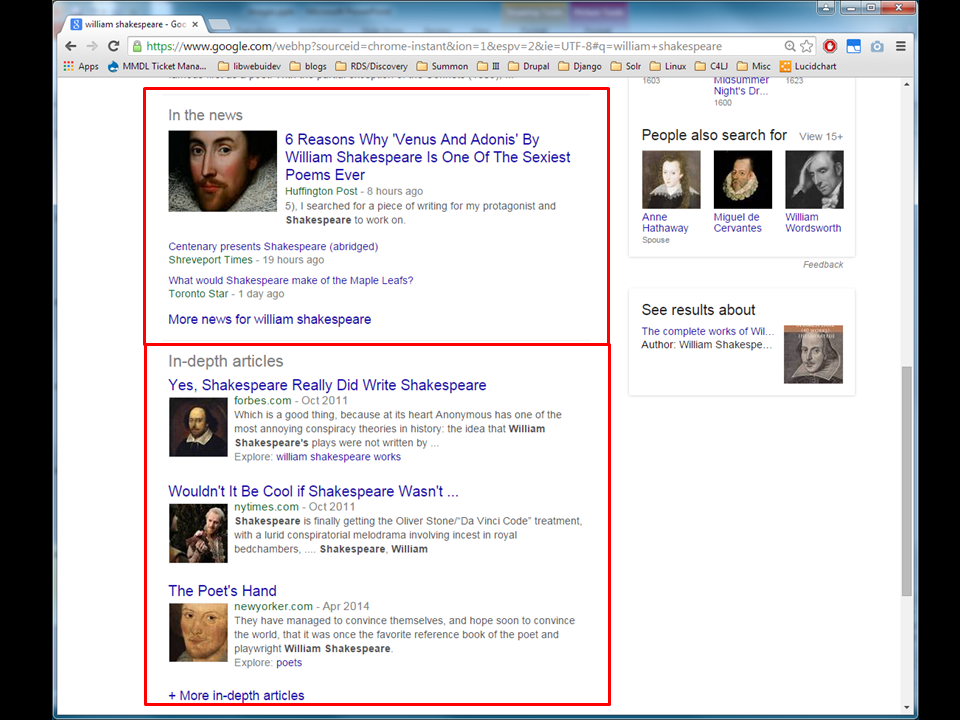
of search system.
Thank you!
Image Credits
Slides 3-6: “bento box” by miheco, licensed under CC BY-SA 2.0
Slide 24: “Hacks” by Katie Spence, licensed under CC BY-NC-ND 2.0
Slide 25: “Playing chess” by Pedro Ribeiro Simões, licensed under CC BY 2.0
Slides 26-27: “Firewood Harvesting” by Kevin Morris, licensed under CC BY-NC 2.0
Image Credits
Slide 28: “screen capture” by davitydave, licensed under CC BY 2.0
Slide 30: “treadmill bike hack” by Frank Hebbert, licensed under CC BY 2.0
Slides 41, 54, 61, 69, 70: “Librarian” by Musgo Dumio_Momio, licensed under CC BY-NC-SA 2.0
Slide 88: “Spider web against sky September 28 03” by Martin LaBar, licensed under CC BY-NC 2.0
Image Credits
Slide 110: “Scattered puzzle pieces next to solved fragment” by Horia Varlan, licensed under CC BY 2.0
Slide 112: “Chupacabra” by Jason Adams, licensed under CC BY-NC-SA 2.0
Slide 113: “Nailed It!” by Bart, licensed under CC BY-NC 2.0
Slide 114: “I want to believe” by mat-, licensed under CC BY-NC-ND 2.0
Image Credits
Slide 117: “Seize The Carp!” by Simona James, licensed under CC BY-SA 2.0
Slides 174, 203, 204: “unbalanced and old” by Julia Manzerova, licensed under CC BY-NC-SA 2.0
Slide 206: “Smoking Gun” by AppleDave, licensed under CC BY-NC 2.0
/